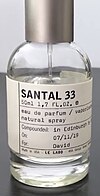Talk:Santal 33
Appearance
A fact from Santal 33 appeared on Wikipedia's Main Page in the Did you know column on 9 January 2021 (check views). The text of the entry was as follows:
|
| This article is rated B-class on Wikipedia's content assessment scale. It is of interest to the following WikiProjects: | |||||||||||||||||||||
| |||||||||||||||||||||
Did you know nomination
[edit]- The following is an archived discussion of the DYK nomination of the article below. Please do not modify this page. Subsequent comments should be made on the appropriate discussion page (such as this nomination's talk page, the article's talk page or Wikipedia talk:Did you know), unless there is consensus to re-open the discussion at this page. No further edits should be made to this page.
The result was: promoted by SL93 (talk) 20:53, 30 December 2020 (UTC)
( )
... the social theory of distinction explains why some people liked the perfume Santal 33 (pictured) less the more popular it became?Source: ”In other words, it isn’t a fragrance so much as a form of social capital. But what happens when that currency becomes a cliché? ... Popularity...lost its claim on what seminal French sociologist Pierre Bourdieu refers to as “distinction,” i.e., the exercise of taste that sets you apart from the rabble. ‘Perfume is about more than smell; it’s about what you think a smell says about you,’ [...] it’s a matter of threading the distinction needle: What people want is a scent that simultaneously establishes their place within a discrete community and marks them out as unique within it... When the fragrance that was empowering you gets decried as ‘basic’ in a video, the jig is up.” (Vogue)
- Comment: I had trouble succinctly quoting the source as she develops this argument over the course of the article—clicking through might make it clearer or let me know if I can help clarify.
- Reviewed: Template:Did you know nominations/Feminism and racism
Created by Innisfree987 (talk). Self-nominated at 05:07, 3 December 2020 (UTC).
- Note (Disclaimer: As a practitioner of a "hard science", I think I may be just a little biased against accepting results of social sciences as if they are fact) Can you add some sort of qualifier in there? "distinction may explain" or "distinction can explain" or (my favorite) "distinction helps explain", but anything similar would work so as to not insinuate that the theory is fact. It's a good theory, but like all things social science, it will forever be up for debate. Note the article is fine, as it makes clear it is one scientist who explained the trend this way and is properly cited and neutral. The hook, on the other hand, makes it seem as though it is an established fact. Footlessmouse (talk) 22:47, 10 December 2020 (UTC)
ALT1:... that, the more popular the perfume Santal 33 (pictured) became, the less some people liked it?ALT2:... the social theory of distinction helps explain why the more popular the perfume Santal 33 (pictured) became, the less some people liked it?
- Thank you for these thoughtful comments Footlessmouse—I agree and coming from the opposite direction, it is very strange to try to comment on social theory in under 200 characters! Appreciate your brainstorming on it. How does this grab you:
- ALT3:... the social theory of distinction could explain why the more popular the perfume Santal 33 (pictured) became, the less some people liked it?
- Just realizing I also owe a QPQ. Will do that now. Innisfree987 (talk) 00:36, 11 December 2020 (UTC)
- I think that works well. Great job! (Note, this was not a review, I just wanted to chime in with thoughts on the hook itself) Footlessmouse (talk) 00:39, 11 December 2020 (UTC)
 New enough, long enough, neutrally written, well referenced, no close paraphrasing seen. Image is freely-licensed; I cropped out the other brands. ALT3 is interesting; hook ref verified and cited inline. QPQ done. ALT3 good to go. Yoninah (talk) 00:51, 25 December 2020 (UTC)
New enough, long enough, neutrally written, well referenced, no close paraphrasing seen. Image is freely-licensed; I cropped out the other brands. ALT3 is interesting; hook ref verified and cited inline. QPQ done. ALT3 good to go. Yoninah (talk) 00:51, 25 December 2020 (UTC)



